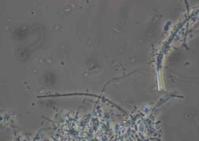JULY 2014
 Type 1701 is the second most common filamentous bacteria found on wastewater treatment facilities in the United States. Type 1701 is a Gram negative, Neisser negative, relatively short curved or bent filaments composed of sausage-shaped cells contained in a tight fitting sheath. Filaments are found mostly in the floc with few, short filaments extending into the bulk solution. Significant amount of attached growth are usually observed. Type 1701 indicates low dissolved oxygen conditions
|
The results from the spring 2014 wastewater operator exam were mailed to the participants in June. Congratulations to those who passed the exam!
Grade Pass Fail % Pass
Grade 1&2 20 5 80%
Grade 3 9 7 56%
Grade 4 2 1 67%
Grade 5 5 7 42%
Phys/Chem 1 3 0 100%
SITS-2 2 0 100%
Overall 41 20 67%
Applications for the November 19th exam are due in the JETCC office by Friday, October 3rd. They must be postmarked by September 29th. If you have questions about the exam, contact JETCC at 253-8020.
Sterling Pierce - (207) 287-4868
1. The unit of electrical power is
a The coulomb
b. The volt
c. The amp
d. The watt
2. The most important test to run to determine if an anaerobic digester is working properly are:
a. BOD, suspended solids and settleable solids
b. PH, alkalinity, and settleable solids
c. Volatile acid/alkalinity relationships
d. DO, volatile solids, and BOD
3. According to EPA regulations, how long must you keep laboratory records and reporting forms that show the quality of the influent and effluent?
a. 3 years
b. 5 years
c. 7 years
d. forever
4. A rectangular flume is 18 inches wide and 18 inches deep. If the flume is full of water flowing at 3 feet per second, how much water is flowing through the flume?
a. 0.58 MGD
b. 02 MGD
c. 4.36 MGD
d. 6.13 MGD
Recently the Department sent a letter to all dischargers to fresh water (N=109) requesting assistance with ambient sampling of rivers and streams above outfalls. The sampling is focused on total phosphorus and total nitrogen. The purpose of the sampling is to obtain a good data set that can be used to determine the need for water quality based limits in discharge permits. Samples can be shipped and analyzed free of charge to the dischargers under a Department contract with Katahdin Analytical Services in Scarborough.
As of July 23, 48 facilities (44%) have contacted Katahdin to request sample bottles to participate in the sampling project. The Department greatly appreciates the efforts of the regulated community to gather this data. If you are not yet participating, we encourage you to join this effort. Katahdin will provide all sampling and shipping materials and analytical services, and the Department contract will cover these costs.
If you wish to participate, please contact Katahdin at 874-2400, and ask for Shelly or Jen regarding the DEP-Rivers and Streams project.
The sampling window runs until September 15. The target flows for sampling are flows below the daily median flow. While flows are currently high throughout much of the state we are hopeful that there will be adequate low flows by the end of the sampling window. Please remember to ice samples adequately to ensure proper temperatures during shipping. Please see the Department’s letter of July 1, 2014 for more details on sampling protocol.
Once again, thanks to all the facilities assisting with this project!
If you have any questions, please contact Brian Kavanah, Director of Division of Water Quality Management, at 287-7700
1. d. The unit of electrical power is the watt.
2. c. In order for an anaerobic digester to work properly, there must be a balance between the organic acids produced by the anaerobic bacteria and the alkalinity of the sludge. The methane forming bacteria use the organic acids for food, but if there is not enough alkalinity to buffer the digester, it becomes too acidic and the methane bacteria are inhibited.
3. a. Records of the plant’s influent and effluent must be kept for 3 years.
4. c. The area of the flume is 1.5 foot X 1.5 foot = 2.25 square feet. If the water flows in the flume at 3 feet per second, the flume delivers 2.25 square feet X 3 feet/Second = 6.75 cubic feet/second (cfs) of flow. Therefore the flume delivers 6.75 cfs X 60 sec/min X 60 min/hr X 24 hr/day X 7.48 gal/cubic foot = 4.36 MGD.
|